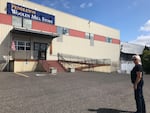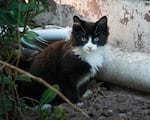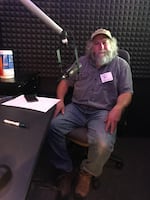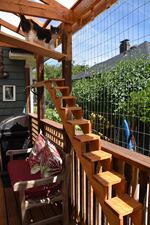Carma Crimins was driving down a street in a Southeast Portland when she noticed a few stray cats near an old building. The next day she went back and to her surprise a few cats turned into 50 feral cats.
"And I couldn’t figure out where are they coming from? There’s no houses — this is totally industrial— these cats are clearly not tamed," Crimins said. "I’m not going to be able to touch them, what am I going to do?"
Fencing kept Crimins from trying to rescue the cats. So she slid a plate filled with cat food under the fence.

Carma Crimins is standing outside the area where she first saw a family of stray cats. She was able to rescue 50 feral cats from this location.
Monica Samayoa
"And I then I went back the next day and I would pull it out and put food in and everyday they were there and everyday there was more of them," Crimins said.
After some research, she found out about a group called the Feral Cat Coalition of Oregon. Its mission is to reduce the population of stray and feral cats by trapping them, neutering them, and if it can’t be tamed or adopted, returning them to the wild, so to speak.
Crimins eventually became a volunteer with the coalition.
This summer it reached a big milestone when the number of neutered cats reached 100,000.

Boo is the Feral Cat Coalition's 100,000th neutered cat. He was helped on 07/19/19.
Photo Credit: Kathi Lamm
Cat lovers consider this Trap Neuter and Return Method an ethical alternative to euthanizing stray and feral cats.
But not everyone agrees that's the best approach to feral cats. Across the country, bird advocates are in conflict with feral cat groups over this matter. One side wants to put feral cats back on the streets — the other side says that just puts more wildlife in mortal danger.
"And that's where the debate has really sat as to whether we should do this trap, neuter, and return, and whether it's an effective strategy," said Bob Sallinger, director of Conservation at Portland Audubon. Its Wildlife Care Center treats about 3,000 animals every year.
The number one cause of intake? Cat predation.
One recent study says feral cats have contributed to the extinction of 63 wildlife species worldwide.

Bob Sallinger is the Director of Conservation at the Audubon Society of Portland. He said the collaboration between the Audubon and the Feral Cat Coalition has been amazing.
Monica Samayoa
For decades the dominant approach to reduce the feral cat population was to euthanize the cats. Portland Audubon’s approach was simply telling people to keep their cats indoors.
But after reviewing decades of data on the practice, Sallinger decided that Portland Audubon's method wasn't working. He wanted to find a new approach.
That's when he learned about the Feral Cat Coalition.
"When I went to their website, what I saw was a mission statement that was almost identical to our goals around this issue, which is basically reducing the number of free-roaming cats in the environment," Sallinger said. "So I reached out to them and said, 'Maybe we have something in common here. Maybe we can work together."
Feral Cat Coalition's Executive Director Karen Kraus said partnering up with the Audubon was an immediate and natural connection as both groups care deeply about animals and want to make Portland safer for both the wildlife and for feral cats.
"Both groups could see where the overlap was and decided that working in that overlap together made us more powerful and better for the community than either one of us working on our own," Kraus said.
After conducting surveys with cat owners in the community a new outreach idea was created —the 'Cats Safe At Home' campaign where the goal is to help educate cat owners about keeping their cats safely indoors to help reduce free-roaming cats, decrease the feral cat population and protect wildlife.
From this Kraus introduced Catios — a do-it-yourself outdoor enclosed safe space for domesticated cats.
"And it's funny for me because when I started this, when this idea was first brought up, Karen Kraus at the Feral Cat Coalition brought it up and I thought, "Yeah, that's a cool idea. That's kind of cute and fun. I'm not sure how effective it will be, but let's go ahead and do it." Sallinger said.
The concept was a big hit.
It motivated the cat community to safely keep their cats indoors while building them a safe space to enjoy the outdoors and also decrease the amount of free roaming and feral cats.
The self-guided catio tour is designed to educate the public on the importance of keeping cats safely indoors and showing them that catios can be built on any type of budget.

One of the many catios built in the Portland Metro area
Courtesy of the Feral Cat Coalition of Oregon
The next catio tour is on Sept. 7. Every year the tour sells out, taking 1,300 animals lovers around the Portland Metro area to view 10 different catios— from extravagant builds like the “Taj Meow” to easy smaller enclosures that can be done on a low budget.
According to Kraus, after this year's event — 70 catios will have been showcased and 500 more can be found all over Portland.
Kraus said the success of the catio tour movement started within the first year, as nearly 700 people registered to attended and surveys taken at the event showed that 75% of people plan to build their own catio.
"We are showing that two groups that work on wildly different topics can find an area of overlap that really strengthens a message to the community in a way that you can't on your own," Kraus said.
Other cities around the nation have followed suit as Catio tours have popped up in Seattle, Austin, and Gainesville, Florida.
